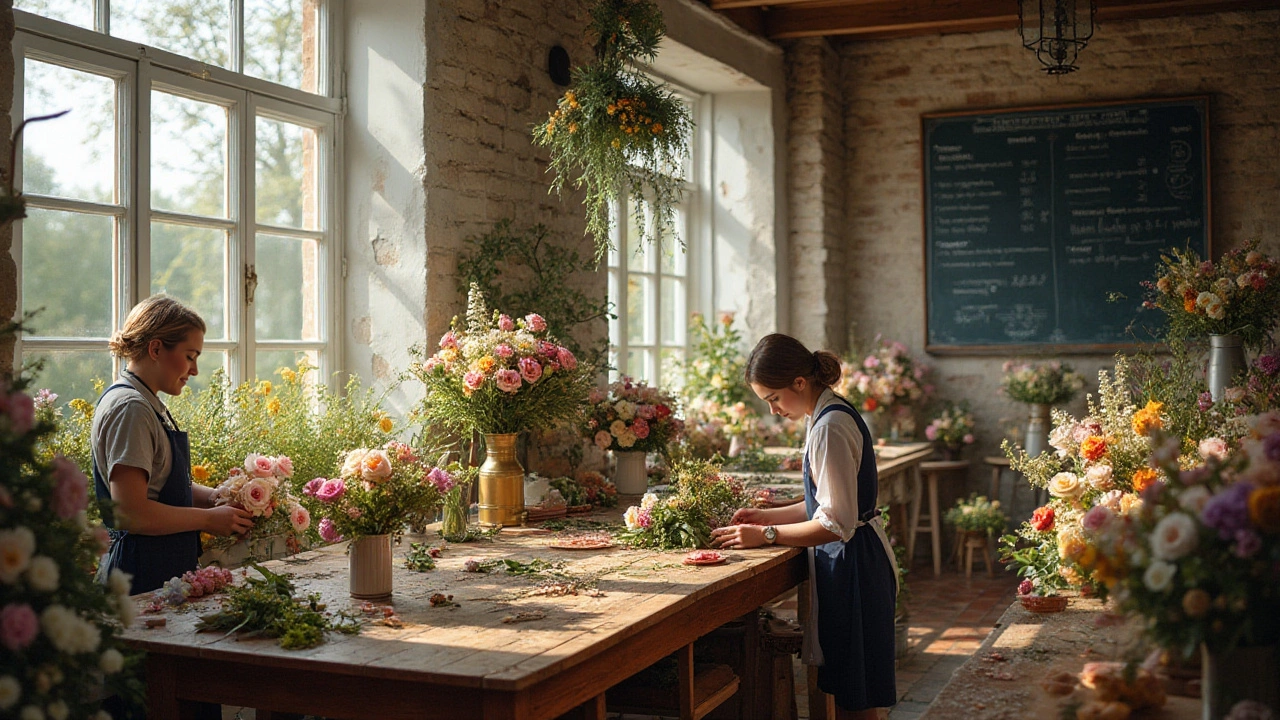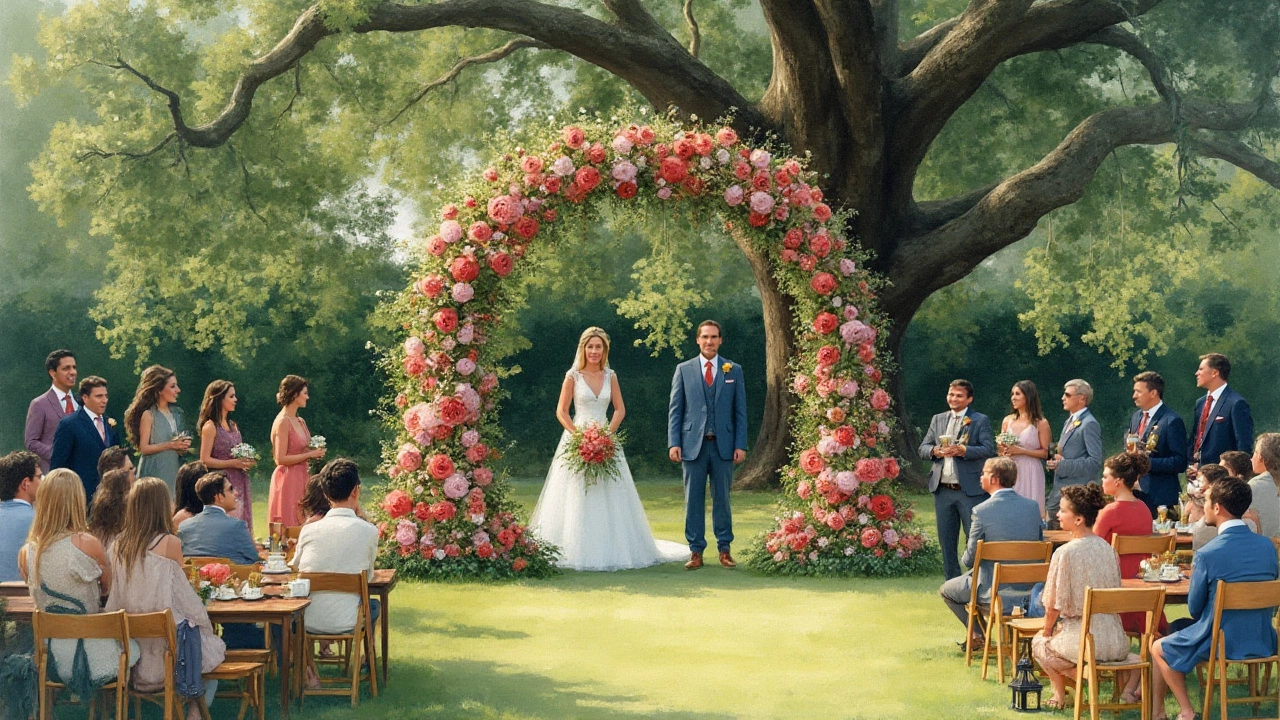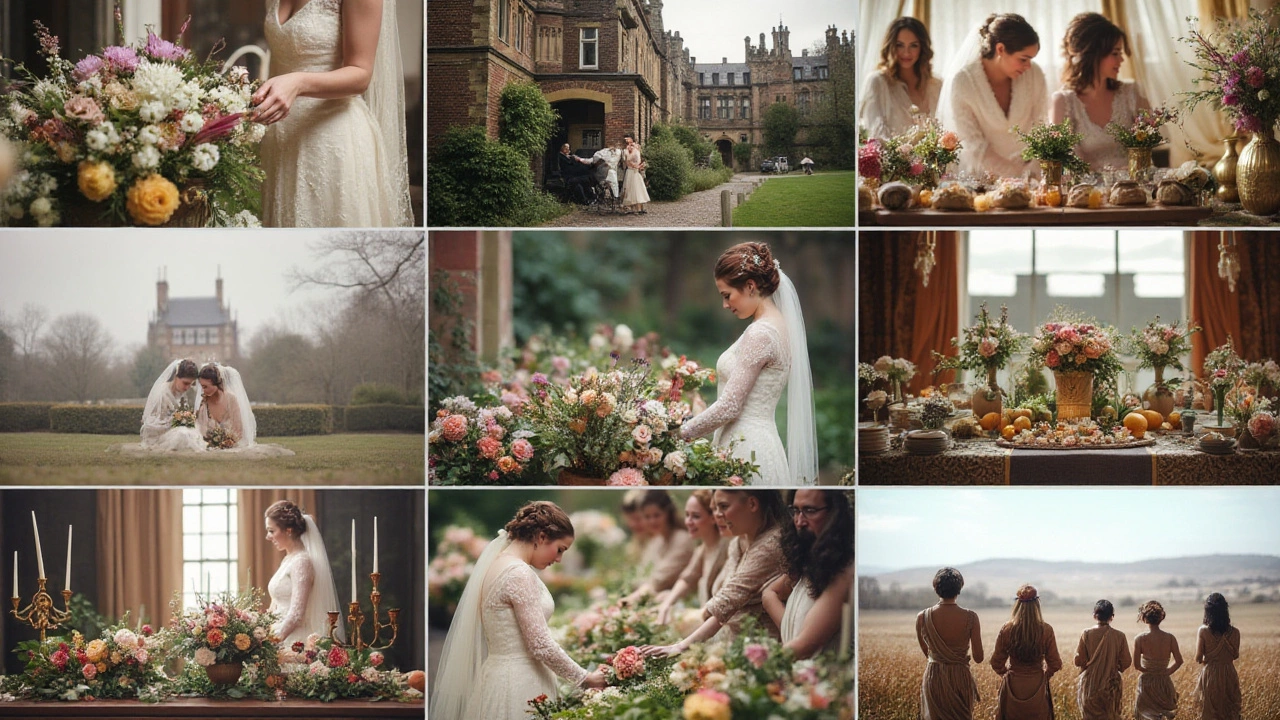Is Spending $2000 on Wedding Flowers Worth It?
 Jan, 31 2025
Jan, 31 2025
Flowers have long held a place of honor in weddings, serving as symbols of love, beauty, and celebration. From cascading bouquets to intricate centerpieces, they can transform a venue into a dreamy wonderland. Many couples might wonder if spending $2000 on wedding flowers feels extravagant or reasonable.
This question doesn't have a one-size-fits-all answer. Several factors can influence this decision, including individual taste, the number of guests, the wedding theme, and choice of flowers. Additionally, imaginative brides and grooms can creatively manipulate their budgets to achieve breathtaking effects without breaking the bank. Join a journey through floral wonder, hearing from couples who made flower magic happen on every scale.
- Understanding the Role of Flowers in Weddings
- How Much to Budget for Wedding Flowers
- High-End vs Budget-Friendly Floral Options
- Creative Ways to Stretch Your Flower Budget
- Real-Life Stories: Splurging and Saving on Flowers
Understanding the Role of Flowers in Weddings
Flowers have been woven into the tapestry of wedding traditions across cultures for centuries. They hold an intrinsic value, not just for their visual appeal but also for their ability to evoke emotions and symbolize purity, new beginnings, and harmony. Each wedding feature counted by guests — the centerpieces, bouquets, and even boutonnieres — whispers tales of sentiment and creativity of the couple's journey into a new chapter. These floral arrangements express individuality and complement a myriad of wedding themes, from rustic charm to modern minimalism.
The profound effect of wedding flowers stems from their versatility. Flowers can transform a venue from ordinary to extraordinary. They have the power to set the entire mood of a ceremony, whether romantic, vibrant, or whimsical. Popular choices like roses, peonies, and lilies offer class and elegance, while wildflower arrangements bring out a playful and organic feel to backyard weddings. Not to mention, the scent of fresh blooms creates an atmosphere unlike any other, captivating the senses of guests the moment they step into the venue.
One might wonder if the tradition holds universal significance or if it might be evolving with modern wedding trends. According to The Knot's Real Weddings Study, about 92% of couples consider flowers a necessary component of their celebration, which shows how deeply integrated floral elements are within wedding rituals today. Different cultures attach distinctive meanings to specific flowers; for instance, cherry blossoms in Japan symbolize ephemeral beauty and life, making them an ideal choice for weddings in spring.
Aside from their traditional roles, flowers can be practical elements within a wedding ceremony. They serve functional purposes too — from guiding the couple and guests through significant parts of the ceremony to offering a visual landmark at reception tables. The creativity doesn't end there; florists and creative planners use flowers to upcycle and repurpose them post-event, contributing immensely to sustainable wedding practices. According to a recent statistic, nearly 57% of wedding planners now advocate for flower recycling or donation after events.
One can't help but be enchanted by how floral designs can be personalized. Each piece can be tailored to a couple’s vision, influenced by the seasons, personal stories, or even a favorite memory. Flowers transcend mere decoration to become part of the storytelling, making every wedding not just a function but a more deeply human experience. As author Sarah Ban Breathnach once said, "The world needs dreamers and the world needs doers. But above all, the world needs dreamers who do." In the context of weddings, it is flowers that inspire dreamers to visualize beautiful realities.
How Much to Budget for Wedding Flowers
Let's tackle the perennial question of how much a couple should allocate for their wedding flowers. This aspect of wedding planning is much more dynamic than it first seems, with the cost hinging on various factors that come to play. The first thing to note is that experts often recommend dedicating about 8% to 10% of your total wedding budget specifically for floral arrangements. This recommendation can, of course, vary based on personal preferences and the importance a couple places on floral arrangements within their dream wedding vision.
The variety, seasonality, and type of blooms directly influence costs. Roses and lilies might be more affordable, but if you're dreaming of peonies or orchids, prepare to splurge a bit more. It's also noteworthy that flowers in season will usually come at a more budget-friendly price. A 2022 wedding industry report highlighted that couples in the U.S. tend to spend an average of $1,500 to $2,500 on wedding flowers, although this varies with location, venue size, and guest count.
"In my experience, even a modest budget can become a lush wonderland with a little creativity and clever planning," says renowned wedding florist Jane Pollen of The Bloom Company.
When planning for your wedding budget, breaking down costs allows for better control. Consider dividing the floral budget into categories like bouquets, centerpieces, ceremony decorations, and reception pieces. This will offer a clearer picture, aiding in making educated choices about where to allocate more funds if necessary, and identifying sections where you can trim costs. A good approach is to prioritize. For instance, a grandiose centerpiece might not be essential if the reception site is naturally stunning.
Let's not forget the hidden costs that may evade notice at the outset. Transport and setup charges often creep in unnoticed, alongside the fees for any special floral installations. Couples who anticipate such expenses can skillfully stretch their dollar, making their passion for flowers a seamless part of their beautiful day.
Recognize the value of consulting with a florist early on. Their expertise can guide through options and help align the vision with the pocketbook. Many florists will work with you to design arrangements that reflect personality and are appropriate to the wedding theme, even within tighter financial constraints. Such supportive relationships are a cornerstone of the wedding planning journey that shouldn't be overlooked.
A practical tip is to also consider purchasing flowers from local or farmer's markets, which often have a broader range of fresh and vibrant options. DIY arrangements can add a personalized touch and can help further in managing costs effectively. Couples today often explore such creative avenues in making their wedding day elegantly special, no matter their budgets.

High-End vs Budget-Friendly Floral Options
When deciding between high-end and budget-friendly floral options for your wedding, the choice often hinges on personal priorities and the ambiance you wish to create. High-end flowers, such as orchids, peonies, and gardenias, come with a sense of luxury and elegance. These blooms, with their exquisite textures and rich fragrances, can leave guests mesmerized by their beauty. However, their premium quality and rarity often come with a steep price tag, making them a splurge for those who are willing to invest significantly in their wedding's aesthetics.
On the other hand, budget-friendly flowers can offer beauty without the hefty cost. Options like carnations, daisies, and baby's breath can be just as charming when arranged creatively. These flowers can be sourced locally, reducing transport costs and supporting community businesses. By choosing in-season blooms, couples not only save money but also ensure the freshness and vitality of the arrangements. It's easy to overlook these simpler blooms, but with a creative florist, they can compete with their high-end counterparts, offering a sustainable and economical alternative.
Interestingly, investing in greenery can also enhance the visual impact without stretching the wallet. The use of lush foliage like ferns and eucalyptus can add volume and texture, creating a dramatic backdrop for more modest blooms. A sustainable approach, using potted plants or even herbs that guests can take home, also provides a creative twist to traditional floral decorations.
According to floral expert Mary Sheehy, "It's not just about the type of flower but how you use them. Mixing textures and colors effectively can make even the simplest arrangement come alive."
"When I plan a wedding, I always encourage my clients to focus on what makes them unique as a couple and to use flowers as an expression of their individual story," she explains.
To further illustrate the possibilities, consider a comparative analysis of costs between these floral options:
| Flower Type | Price Range (per stem) | In-Season Months |
|---|---|---|
| Orchids | $2 - $5 | January - December |
| Peonies | $3 - $7 | April - June |
| Carnations | $0.50 - $2 | January - December |
| Daisies | $0.40 - $1.50 | April - August |
Deciding whether to indulge in top-tier florals or embrace more affordable alternatives depends heavily on individual preferences and budget constraints. Regardless of the path chosen, today's couples have a myriad of options to tailor their wedding day to reflect their personal style while staying financially savvy.
Creative Ways to Stretch Your Flower Budget
When planning a wedding, flowers can easily become a significant expense, but with a sprinkle of creativity, it's possible to stretch your budget without compromising on beauty. Whether you're striving for a minimalist feel or an opulent display, making savvy choices about your floral purchases can lead to substantial savings. Start by considering the seasonality of your chosen wedding flowers. Flowers that are in season are generally more affordable than exotic varieties imported from faraway locales. For example, tulips in spring or chrysanthemums in autumn are not only timely but can enliven your arrangements without straining your budget.
An excellent strategy is opting for locally sourced flowers. Besides being environmentally friendly, reducing the need for transportation can cut costs. Visit local farmers' markets or floral cooperatives to explore an array of seasonal blossoms. Additionally, the use of greenery can significantly expand the lushness of your arrangements without adding substantial costs. Foliage like eucalyptus or ruscus can make arrangements appear fuller and more verdant.
As event planner Lisa Vorce says, "Greenery is beautiful, can add volume, and often costs a fraction of what a full floral bouquet might."
Another effective approach is to repurpose arrangements throughout your wedding day. Ceremony arrangements, for instance, can double as decoration for the reception venue. Build adaptability into your floral plan by designing arrangements like bouquets and centerpieces that fit a variety of spaces. Also, consider working with reusable materials. Vases, pots, and ornamental elements can be borrowed or rented, significantly diminishing expenses while still delivering visual impact.
DIY projects offer both personalization and savings. Creating your own floral arrangements can deepen the sentimental value of your decor. With plenty of online tutorials and workshops available, even the least flower-savvy individuals can craft attractive bouquets and installations. Gather friends and family to help; this hands-on collaboration can also serve as a bonding experience before your special day. If DIY feels daunting, consider a hybrid approach by purchasing pre-arranged bundles or kits that allow you some personal touches.
Embrace the concept of less is more. Not every table or corner needs to be overflowing with blooms. Accent flowers or a singular statement piece can be just as striking, setting the stage for memorable impressions. By focusing on key focal points, you direct guests' gaze to specific areas rich in floral artistry. Complement the florals with other decor elements like candles or drapery to balance the look and feel without the extra florals.

Real-Life Stories: Splurging and Saving on Flowers
Weddings are as diverse as the stories behind them, with every couple finding a unique way to navigate the puzzle of budgeting, aesthetics, and personal preference, especially when it comes to wedding flowers. Some choose to dive headfirst into floral opulence, turning their venues into literal gardens, while others strategically sidestep the luxury of extravagance, finding beauty in simplicity and sustainability.
Meet Emily and Jake, who were inspired by a romantic novel for their grand floral display. They envisioned a sea of lilies, roses, and hydrangeas adorning every corner of their venue. The feel was enchanting, straight out of a fairy tale. Their budget for wedding flowers climbed to the upper echelons at $5000, a choice driven by the importance they placed on making the day feel dream-like. They collaborated with a renowned floral designer who handpicked each bloom. To them, this expenditure was worth every cent—an investment in the memories they create that day. As Emily recalls, "When the guests walked in, the fragrance and florals evoked collective gasps. It set the perfect tone." Their splurge reflected a personal priority that they valued—with flowers that stole the show.
On the flip side, there's Sarah and Tom, whose approach leaned towards budget-savvy efficiency without compromising on elegance. They did not wish to overspend on wedding flowers, reserving only 20% of their entire floral budget for succulents and wildflowers. Their secret? Leveraging seasonal blooms and supporting local nurseries, which meant the flowers were not only fresh and vibrant, but also priced more reasonably. They worked closely with a passionate florist who suggested rustic arrangements that tied seamlessly into the wooden setting of their barn wedding. The guests adored the eclectic charm and the thoughtfulness that went into each piece.
Their approach was equally unforgettable and wise, showcasing how a creative vision coupled with financial prudence can achieve stunning results. In the words of Sarah, "Our wedding at its core was about intimacy and nature, and even with budget-friendly floral options, our day felt perfectly us." These real-life stories exemplify the myriad ways to shape a wedding's style and atmosphere, reliant on the unique preference and personal philosophy each couple holds dear.